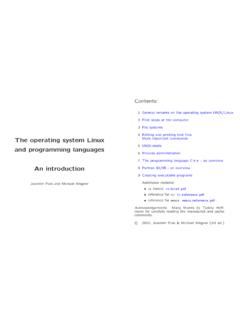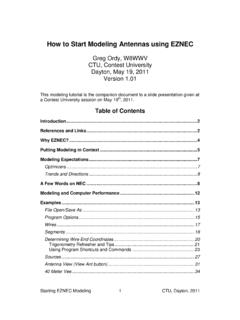Transcription of Introduction to Python - Harvard University
1 Introduction to PythonHeavily based on presentations by Matt Huenerfauth (Penn State) Guido van Rossum (Google) Richard P. Muller (Caltech) ..Monday, October 19, 2009 Open source general-purpose language. Object Oriented, Procedural, Functional Easy to interface with C/ObjC/Java/ fortran Easy-ish to interface with C++ (via SWIG) Great interactive environment Downloads: Documentation: Free book: , October 19, 2009 / / ??? Current version is Mainstream version is The new kid on the block is probably want unless you are starting from scratch. Then maybe , October 19, 2009 Technical IssuesInstalling & Running PythonMonday, October 19, 2009 Binaries Python comes pre-installed with Mac OS X and Linux. Windows binaries from You might not have to do anything!
2 Monday, October 19, 2009 The Python Interpreter Interactive interface to Python % pythonPython (r25:51908, May 25 2007, 16:14:04) [GCC 20061115 (prerelease) (SUSE Linux)] on linux2 Type "help", "copyright", "credits" or "license" for more information.>>> Python interpreter evaluates inputs: >>> 3*(7+2) 27 Python prompts with >>> . To exit Python : CTRL-DMonday, October 19, 2009 Running Programs on UNIX% Python You could make the *.py file executable and add the following #!/usr/bin/env Python to the top to make it , October 19, 2009 Batteries Included Large collection of proven modules included in the standard , October 19, 2009 numpy Offers Matlab-ish capabilities within Python Fast array operations 2D arrays, multi-D arrays, linear algebra etc.
3 Downloads: Tutorial: , October 19, 2009 matplotlib High quality plotting library. Downloads: #!/usr/bin/env pythonimport numpy as npimport as mlabimport as pltmu, sigma = 100, 15x = mu + sigma* (10000)# the histogram of the datan, bins, patches = (x, 50, normed=1, facecolor='green', alpha= )# add a 'best fit' liney = ( bins, mu, sigma)l = (bins, y, 'r--', linewidth=1) ('Smarts') ('Probability') (r'$\mathrm{Histogram\ of\ IQ:}\ \mu=100,\ \sigma=15$') ([40, 160, 0, ]) (True) ()Monday, October 19, 2009 PyFITS FITS I/O made simple: Downloads: >>> import pyfits>>> hdulist = ( )>>> () Filename: No. Name Type Cards Dimensions Format 0 PRIMARY PrimaryHDU 220 () Int16 1 SCI ImageHDU 61 (800, 800) Float32 2 SCI ImageHDU 61 (800, 800) Float32 3 SCI ImageHDU 61 (800, 800) Float32 4 SCI ImageHDU 61 (800, 800) Float32>>> hdulist[0].
4 Header[ targname ] NGC121 >>> scidata = hdulist[1].data>>> (800, 800) >>> float32 >>> scidata[30:40,10:20] = scidata[1,4] = 999 Monday, October 19, 2009 pyds9 / Python -sao Interaction with DS9 Display Python 1-D and 2-D arrays in DS9 Display FITS files in DS9 Downloads: Ask Eric Mandel :-) Downloads: , October 19, 2009 Wrappers for Astronomical Packages CasaPy (Casa) PYGILDAS (GILDAS) ParselTongue (AIPS) PyRAF (IRAF) PyMIDAS (MIDAS) PyIMSL (IMSL)Monday, October 19, 2009 Custom Distributions Python (x,y): Python (x,y) is a free scientific and engineering development software for numerical computations, data analysis and data visualization Sage: Sage is a free open-source mathematics software system licensed under the GPL. It combines the power of many existing open-source packages into a common Python -based interface.
5 Monday, October 19, 2009 Extra Astronomy Links iPython (better shell, distributed computing): SciPy (collection of science tools): Python Astronomy Modules: Python Astronomer Wiki: AstroPy: Python for Astronomers: , October 19, 2009 The BasicsMonday, October 19, 2009 A Code Sample x = 34 - 23 # A comment. y = Hello # Another one. z = if z == or y == Hello : x = x + 1 y = y + World # String concat. print x print yMonday, October 19, 2009 Enough to Understand the Code Assignment uses = and comparison uses ==. For numbers + - * / % are as expected. Special use of + for string concatenation. Special use of % for string formatting (as with printf in C) Logical operators are words (and, or, not) not symbols The basic printing command is print.
6 The first assignment to a variable creates it. Variable types don t need to be declared. Python figures out the variable types on its own. Monday, October 19, 2009 Basic Datatypes Integers (default for numbers)z = 5 / 2 # Answer is 2, integer division. Floatsx = Strings Can use or to specify. abc abc (Same thing.) Unmatched can occur within the string. matt s Use triple double-quotes for multi-line strings or strings than contain both and inside of them: a b c Monday, October 19, 2009 WhitespaceWhitespace is meaningful in Python : especially indentation and placement of newlines. Use a newline to end a line of code. Use \ when must go to next line prematurely. No braces { } to mark blocks of code in Use consistent indentation instead.
7 The first line with less indentation is outside of the block. The first line with more indentation starts a nested block Often a colon appears at the start of a new block. ( for function and class definitions.)Monday, October 19, 2009 Comments Start comments with # the rest of line is ignored. Can include a documentation string as the first line of any new function or class that you define. The development environment, debugger, and other tools use it: it s good style to include my_function(x, y): This is the docstring. This function does blah blah blah. # The code would go Monday, October 19, 2009 Assignment Binding a variable in Python means setting a name to hold a reference to some object. Assignment creates references, not copies Names in Python do not have an intrinsic type.
8 Objects have types. Python determines the type of the reference automatically based on the data object assigned to it. You create a name the first time it appears on the left side of an assignment expression: !x = 3 A reference is deleted via garbage collection after any names bound to it have passed out of , October 19, 2009 Accessing Non-Existent Names If you try to access a name before it s been properly created (by placing it on the left side of an assignment), you ll get an error. >>> yTraceback (most recent call last): File "<pyshell#16>", line 1, in -toplevel- yNameError: name y' is not defined>>> y = 3>>> y3 Monday, October 19, 2009 Multiple Assignment You can also assign to multiple names at the same time. >>> x, y = 2, 3>>> x2>>> y3 Monday, October 19, 2009 Naming Rules Names are case sensitive and cannot start with a number.
9 They can contain letters, numbers, and underscores. bob Bob _bob _2_bob_ bob_2 BoB There are some reserved words: and, assert, break, class, continue, def, del, elif, else, except, exec, finally, for, from, global, if, import, in, is, lambda, not, or, pass, print, raise, return, try, whileMonday, October 19, 2009 Understanding Reference Semantics in PythonMonday, October 19, 2009 Understanding Reference Semantics Assignment manipulates references x = y does not make a copy of the object y references x = y makes x reference the object y references Very useful; but beware! Example:>>> a = [1, 2, 3] # a now references the list [1, 2, 3]>>> b = a # b now references what a references>>> (4) # this changes the list a references >>> print b # if we print what b references,[1, 2, 3, 4] # SURPRISE!
10 It has Why??Monday, October 19, 2009 Understanding Reference Semantics II There is a lot going on when we type:x = 3 First, an integer 3 is created and stored in memory A name x is created An reference to the memory location storing the 3 is then assigned to the name x So: When we say that the value of x is 3 we mean that x now refers to the integer 3 Type: IntegerData: 3 Name: xRef: <address1>name listmemoryMonday, October 19, 2009 Understanding Reference Semantics III The data 3 we created is of type integer. In Python , the datatypes integer, float, and string (and tuple) are immutable. This doesn t mean we can t change the value of x, change what x refers to .. For example, we could increment x:>>> x = 3>>> x = x + 1>>> print x4 Monday, October 19, 2009 Understanding Reference Semantics IV If we increment x, then what s really happening reference of name x is looked value at that reference is : IntegerData: 3 Name: xRef: <address1>>>> x = x + 1 Monday, October 19, 2009 Understanding Reference Semantics IV If we increment x, then what s really happening reference of name x is looked value at that reference is 3+1 calculation occurs, producing a new data element 4 which is assigned to a fresh memory location with a new : IntegerData: 3 Name: xRef: <address1>Type: IntegerData.

